There are currently over 100 satellites which transmit (either as their downlink, or as a beacon) in the 70 cm amateur band. The frequency range 432 - 438 MHz is internationally allocated to the Earth Exploration Satellite Service on a secondary basis, however most of the satellites generally use the amateur satellite allocation of 435 - 438 MHz.
Permission to use the amateur frequencies is given by footnote 5.282 of the frequency allocation table in the ITU Radio Regulations, which states:
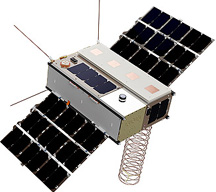 Wireless Waffle wanted to know if there was a particular hotspot within this frequency range where the majority of satellties were clustered, which would make it easier to set up a software radio (SDR) to search for these fleeting signals.
Wireless Waffle wanted to know if there was a particular hotspot within this frequency range where the majority of satellties were clustered, which would make it easier to set up a software radio (SDR) to search for these fleeting signals.
A bit of digging revealed a file containing all of the frequencies used by these satellites and some deft work with Excel formulas then revealed the answer to the question. And the answer is that the majority use frequencies between 437.2 and 437.6 MHz. Of the 176 active satellites frequencies analysed, 100 (or 57%) use frequencies in this range. So now you know and can sleep more soundly in your bed!
Permission to use the amateur frequencies is given by footnote 5.282 of the frequency allocation table in the ITU Radio Regulations, which states:
In the bands 435-438 MHz, 1 260-1 270 MHz, 2 400-2 450 MHz, 3 400-3 410 MHz (in Regions 2 and 3 only) and 5 650-5 670 MHz, the amateur-satellite service may operate subject to not causing harmful interference to other
services operating in accordance with the Table...
 Wireless Waffle wanted to know if there was a particular hotspot within this frequency range where the majority of satellties were clustered, which would make it easier to set up a software radio (SDR) to search for these fleeting signals.
Wireless Waffle wanted to know if there was a particular hotspot within this frequency range where the majority of satellties were clustered, which would make it easier to set up a software radio (SDR) to search for these fleeting signals.A bit of digging revealed a file containing all of the frequencies used by these satellites and some deft work with Excel formulas then revealed the answer to the question. And the answer is that the majority use frequencies between 437.2 and 437.6 MHz. Of the 176 active satellites frequencies analysed, 100 (or 57%) use frequencies in this range. So now you know and can sleep more soundly in your bed!
add comment
( 2294 views )
| permalink
| 



 ( 2.7 / 976 )
( 2.7 / 976 )




 ( 2.7 / 976 )
( 2.7 / 976 )
A lot of countries are beginning to consider the use of what is known as 'C-band' for new 5G services. The C-band runs from 3400 - 4200 MHz and is a set of radio frequencies extensively used for satellite connections (and for some point-to-point fixed links and the odd point-to-multipoint network). The satellite uses connections fall into a number of categories:
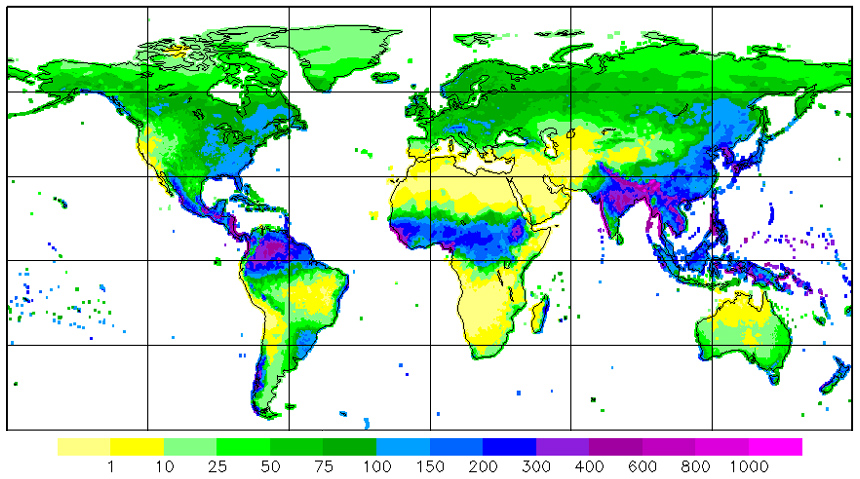
As can be seen from the map above (click for a bigger version), there is a swathe of the world, primarily in equatorial areas, where it really rains (those in blue and purple). In these areas, signals in other satellite frequency bands, such as Ku-band (11 GHz) and Ka-band (20 GHz) are absorbed so much by rain that when it pours, they become unreceivable but C-band being a lower frequency (4 GHz) does not. Using the band for 5G in countries where C-band is only lightly used is not impossible. Though 5G transmissions can wipe-out satellite reception in areas hundreds of kilometers from the 5G base stations, very careful planning of frequencies and site placements can lead to some solutions.
In countries, however, where there are hundreds of VSAT terminals, or thousands of domestic satellite receivers, the situation is more bleak. There is fundamentally no way that 5G networks and satellite receivers can share the same frequencies. The transmitter power of a satellite is not completely dissimilar to that of a 5G base station, but one is 40,000 kilometers away and the other may be 40 metres away. Clearly one will enormously overshadow the other.
The only way that the two services can therefore co-exist is to separate the 5G frequencies from those used for satellite reception.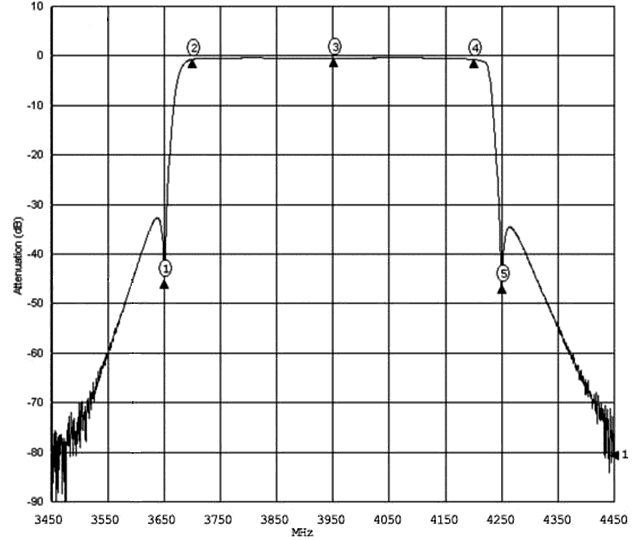 As there are no 'unused' satellite frequencies in the C-band, this means that regulators have to take a decision to slice up the band, taking spectrum away from satellites and giving it to 5G services and this is what many have done. Hong Kong, Cambodia, Singapore and the Philippines (to mention a few) have decided to use frequencies from 3400 - 3600 MHz for 5G services, and leave 3700 - 4200 MHz for satellite services. The gap in-between (3600 - 3700 MHz) is left as a guard-band, a kind of no-mans-land in which neither service has priority. This allows satellite receivers to be fitted with filters which allow signals above 3700 MHz through, whilst rejecting signals below 3600 MHz (see the example on the right).
As there are no 'unused' satellite frequencies in the C-band, this means that regulators have to take a decision to slice up the band, taking spectrum away from satellites and giving it to 5G services and this is what many have done. Hong Kong, Cambodia, Singapore and the Philippines (to mention a few) have decided to use frequencies from 3400 - 3600 MHz for 5G services, and leave 3700 - 4200 MHz for satellite services. The gap in-between (3600 - 3700 MHz) is left as a guard-band, a kind of no-mans-land in which neither service has priority. This allows satellite receivers to be fitted with filters which allow signals above 3700 MHz through, whilst rejecting signals below 3600 MHz (see the example on the right).
In such a scenario, there is still potential for interference to the satellite services in two possible ways:
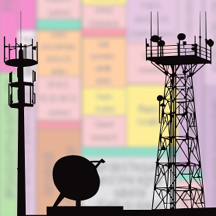 The solution to this, would be to fit filters to the 5G transmitters to reduce the unwanted emissions, but this costs the mobile operators and they are not keen to do so. In some cases they are not even able to do so. The use of 'massive MIMO' antennas means that the transmitters and antennas are incorporated into a single unit, inside which there is no room to fit a filter.
The solution to this, would be to fit filters to the 5G transmitters to reduce the unwanted emissions, but this costs the mobile operators and they are not keen to do so. In some cases they are not even able to do so. The use of 'massive MIMO' antennas means that the transmitters and antennas are incorporated into a single unit, inside which there is no room to fit a filter.
Sharing of the C-band between satellite services and 5G networks therefore remains a thorny issue and it will be interesting to see how the problem is resolved. One option is, of course, to use a different band in areas where C-band satellite is in strong demand. The 2.6 GHz band (2500 - 2690 MHz) is currently built in to every 5G phone that is on the market and in the near future the millimetre wave bands (26 GHz and above) will form part of the ecosystem, so maybe the satellite operators will be left alone in their C-band spectrum in places where it never rains, but it pours.
- Lifeblood links for remote areas (including some countries whose only international connection is via satellite such as Ascension Island).
- VSAT connections for businesses (i.e. banks and petrol stations) and for remote internet connections.
- Domestic television reception.

As can be seen from the map above (click for a bigger version), there is a swathe of the world, primarily in equatorial areas, where it really rains (those in blue and purple). In these areas, signals in other satellite frequency bands, such as Ku-band (11 GHz) and Ka-band (20 GHz) are absorbed so much by rain that when it pours, they become unreceivable but C-band being a lower frequency (4 GHz) does not. Using the band for 5G in countries where C-band is only lightly used is not impossible. Though 5G transmissions can wipe-out satellite reception in areas hundreds of kilometers from the 5G base stations, very careful planning of frequencies and site placements can lead to some solutions.
In countries, however, where there are hundreds of VSAT terminals, or thousands of domestic satellite receivers, the situation is more bleak. There is fundamentally no way that 5G networks and satellite receivers can share the same frequencies. The transmitter power of a satellite is not completely dissimilar to that of a 5G base station, but one is 40,000 kilometers away and the other may be 40 metres away. Clearly one will enormously overshadow the other.
The only way that the two services can therefore co-exist is to separate the 5G frequencies from those used for satellite reception.
 As there are no 'unused' satellite frequencies in the C-band, this means that regulators have to take a decision to slice up the band, taking spectrum away from satellites and giving it to 5G services and this is what many have done. Hong Kong, Cambodia, Singapore and the Philippines (to mention a few) have decided to use frequencies from 3400 - 3600 MHz for 5G services, and leave 3700 - 4200 MHz for satellite services. The gap in-between (3600 - 3700 MHz) is left as a guard-band, a kind of no-mans-land in which neither service has priority. This allows satellite receivers to be fitted with filters which allow signals above 3700 MHz through, whilst rejecting signals below 3600 MHz (see the example on the right).
As there are no 'unused' satellite frequencies in the C-band, this means that regulators have to take a decision to slice up the band, taking spectrum away from satellites and giving it to 5G services and this is what many have done. Hong Kong, Cambodia, Singapore and the Philippines (to mention a few) have decided to use frequencies from 3400 - 3600 MHz for 5G services, and leave 3700 - 4200 MHz for satellite services. The gap in-between (3600 - 3700 MHz) is left as a guard-band, a kind of no-mans-land in which neither service has priority. This allows satellite receivers to be fitted with filters which allow signals above 3700 MHz through, whilst rejecting signals below 3600 MHz (see the example on the right).In such a scenario, there is still potential for interference to the satellite services in two possible ways:
- strong signals from the 5G transmitters can overload the satellite receivers (even after the rejection provided by the filter); or
- unwanted emissions from the 5G transmitters on the frequencies being received by the satellites can cause interference.
 The solution to this, would be to fit filters to the 5G transmitters to reduce the unwanted emissions, but this costs the mobile operators and they are not keen to do so. In some cases they are not even able to do so. The use of 'massive MIMO' antennas means that the transmitters and antennas are incorporated into a single unit, inside which there is no room to fit a filter.
The solution to this, would be to fit filters to the 5G transmitters to reduce the unwanted emissions, but this costs the mobile operators and they are not keen to do so. In some cases they are not even able to do so. The use of 'massive MIMO' antennas means that the transmitters and antennas are incorporated into a single unit, inside which there is no room to fit a filter.Sharing of the C-band between satellite services and 5G networks therefore remains a thorny issue and it will be interesting to see how the problem is resolved. One option is, of course, to use a different band in areas where C-band satellite is in strong demand. The 2.6 GHz band (2500 - 2690 MHz) is currently built in to every 5G phone that is on the market and in the near future the millimetre wave bands (26 GHz and above) will form part of the ecosystem, so maybe the satellite operators will be left alone in their C-band spectrum in places where it never rains, but it pours.
Wednesday 23 September, 2015, 12:36 - Satellites
Posted by Administrator
Posted by Administrator
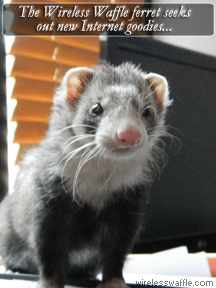 On several previous occasions, Wireless Waffle has discussed some of the problems, both technical and economic that the raft of companies planning to launch new constellations of high throughput, broadband delivering, satellites may face in making their services a success. Whilst ferreting around the internet, it was interesting to discover a paper entitled 'LEO: Roar or Whimper' which discussed many of the same issues on which Wireless Waffle has opined in the past.
On several previous occasions, Wireless Waffle has discussed some of the problems, both technical and economic that the raft of companies planning to launch new constellations of high throughput, broadband delivering, satellites may face in making their services a success. Whilst ferreting around the internet, it was interesting to discover a paper entitled 'LEO: Roar or Whimper' which discussed many of the same issues on which Wireless Waffle has opined in the past.The paper, however, takes a more sideways approach and compares the situation facing new operators such as WorldVu and SpaceX who are intending to launch literally thousands of satellites to provide broadband services, with satellite broadband networks that were planned to do just the same thing in the 1990s (such as Teledesic and Skybridge) but which never got off the ground (so to speak).
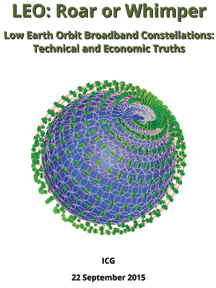 It turns out that many of the potential hazards facing today's planned satellite networks have changed little since the 1990s and in some cases the situation may have gotten worse. Take for example the amount of space debris now hanging around at various orbits which is much greater than it was 20 years ago. And though the technology has moved on, the costs of implementing complex satellite earth stations that can track the satellites are no less soluble today than they where when the Spice Girls were topping the charts, even with the advent of leading-edge technologies such as meta-materials. There are a range of other issues discussed in the paper which seems to consider the landscape for the LEO networks to be relatively bleak and foreboding despite many big name investors backing these projects.
It turns out that many of the potential hazards facing today's planned satellite networks have changed little since the 1990s and in some cases the situation may have gotten worse. Take for example the amount of space debris now hanging around at various orbits which is much greater than it was 20 years ago. And though the technology has moved on, the costs of implementing complex satellite earth stations that can track the satellites are no less soluble today than they where when the Spice Girls were topping the charts, even with the advent of leading-edge technologies such as meta-materials. There are a range of other issues discussed in the paper which seems to consider the landscape for the LEO networks to be relatively bleak and foreboding despite many big name investors backing these projects.For what it's worth, the Wireless Waffle answer to the question posed in the paper's title, 'LEO: Roar or Whimper', is that it seems that the LEOs will roar, but quite possibly directing their volume at people who are wearing noise cancelling headphones and thus won't hear their bellowing cry. Metaphorically speaking!
The bedrock of the recommendations posited by many consulting companies involved in radio spectrum management is the cost-benefit analysis. The principal of such an analysis is quite straightforward - you calculate the cost of doing something and then evaluate the benefits of the same thing and compare one with the other. If the benefits outweight the costs, then it should be worth doing. If the costs outweigh the benefits then it is not worth doing.
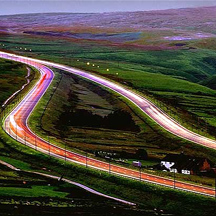 But many such analyses are incomplete. As an example, consider the case of building a new motorway over some existing farmland. A typical analysis would look at the costs in terms of the need to find alternative employment for the farmers whose land will be compulsorily purchased to turn into the motorway. The benefits would be calculated to drivers, whose journeys would be shortened and therefore who would save time and money (for fuel). This is not the whole picture: it misses a whole set of costs and a whole set of benefits. It does not take into account the cost of building the motorway, and it fails to consider the benefits being generated from the farmland (e.g. the value of the business being conducted by the farmers). The table below illustrates what a full analysis might look like.
But many such analyses are incomplete. As an example, consider the case of building a new motorway over some existing farmland. A typical analysis would look at the costs in terms of the need to find alternative employment for the farmers whose land will be compulsorily purchased to turn into the motorway. The benefits would be calculated to drivers, whose journeys would be shortened and therefore who would save time and money (for fuel). This is not the whole picture: it misses a whole set of costs and a whole set of benefits. It does not take into account the cost of building the motorway, and it fails to consider the benefits being generated from the farmland (e.g. the value of the business being conducted by the farmers). The table below illustrates what a full analysis might look like.
It might also be informative to consider other ways that the same benefits might be delivered, for example by re-engineering existing roads, or by using more fuel efficient cars.
None of this is rocket science and even those studying economics at school ought to be able to identify all of the costs and benefits. It is surprising, therefore, that some otherwise well-respected economists continue to write reports that miss out parts of the analysis. Plum Consulting (no stranger to Wireless Waffle) have recently published a report entitled 'Use of C-Band for mobile broadband in Hungary, Italy, Sweden and the UK'. In it they conduct a cost-benefit analysis of migrating existing spectrum users out of the C-Band (3400 - 4200 MHz) and using it for mobile broadband services. But as with the example above, they fail to consider all the cost and all the benefits. They consider the costs to existing users, and benefits to the new users, but not the benefits to existing users or costs to the new users. The table below summarises their analysis.
In addition to missing a large chunk of the necessary analysis, they also do not assess alternative methods to achieve the same outcome. For example, no consideration is given to whether the improved spectrum efficiency of 5G networks (which will presumably have started being rolled-out in the timescales considered in the report) would be more cost effective for the mobile broadband operators than using older technology in a new band. The fact that the costs to the mobile operators are not evaluated serves to hide alternative solutions such as this.
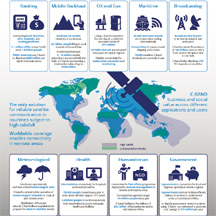 Of course the report has been paid for by Ericsson, Huawei and Qualcomm and so it would be expected that the results would show in favour of the mobile industry, and so missing out various parts of the analysis which might make the results less favourable is perhaps no surprise. It is also the case that, for example, evaluating the value of the spectrum to the existing users is a complicated task due to the very wide range of types of users that would have to be considered, from the oil and gas industry to banks, and from broadcasting to humanitarian relief. The Satellite Spectrum Initiative have published a helpful factsheet which identifies and, to some extent, quantifies, the value of the use of C-band to various users. To actually value the C-band properly is a big task which it seems that even the satellite operators who stand to lose most if the spectrum is re-farmed for mobile services, are unwilling to cough up the funds needed to put a figure on it.
Of course the report has been paid for by Ericsson, Huawei and Qualcomm and so it would be expected that the results would show in favour of the mobile industry, and so missing out various parts of the analysis which might make the results less favourable is perhaps no surprise. It is also the case that, for example, evaluating the value of the spectrum to the existing users is a complicated task due to the very wide range of types of users that would have to be considered, from the oil and gas industry to banks, and from broadcasting to humanitarian relief. The Satellite Spectrum Initiative have published a helpful factsheet which identifies and, to some extent, quantifies, the value of the use of C-band to various users. To actually value the C-band properly is a big task which it seems that even the satellite operators who stand to lose most if the spectrum is re-farmed for mobile services, are unwilling to cough up the funds needed to put a figure on it.
 Until such time as someone does pay to do the job properly, it seems that all discussions on the value of C-band spectrum to satellite operators or to mobile operators will be conducted without all the facts being on the table. With C-band being a hotly contended issue at the forthcoming World Radiocommunication Conference (WRC) (which will take place at the ITU in November in Geneva) any decisions taken will be rather uninformed. Such important decisions, with billions of pounds of mobile and satellite money involved, should not be taken so lightly. Maybe those users who rely on C-band for their businesses today could club together and raise enough money for decent economics experts to actually work out a realistic value of today's C-band use, and equally the mobile industry could do a full analysis of the costs and benefits of the use of the band, and of other alternatives so that all concerned could be comfortable that they are taking any decisions on a realistic basis.
Until such time as someone does pay to do the job properly, it seems that all discussions on the value of C-band spectrum to satellite operators or to mobile operators will be conducted without all the facts being on the table. With C-band being a hotly contended issue at the forthcoming World Radiocommunication Conference (WRC) (which will take place at the ITU in November in Geneva) any decisions taken will be rather uninformed. Such important decisions, with billions of pounds of mobile and satellite money involved, should not be taken so lightly. Maybe those users who rely on C-band for their businesses today could club together and raise enough money for decent economics experts to actually work out a realistic value of today's C-band use, and equally the mobile industry could do a full analysis of the costs and benefits of the use of the band, and of other alternatives so that all concerned could be comfortable that they are taking any decisions on a realistic basis.
 But many such analyses are incomplete. As an example, consider the case of building a new motorway over some existing farmland. A typical analysis would look at the costs in terms of the need to find alternative employment for the farmers whose land will be compulsorily purchased to turn into the motorway. The benefits would be calculated to drivers, whose journeys would be shortened and therefore who would save time and money (for fuel). This is not the whole picture: it misses a whole set of costs and a whole set of benefits. It does not take into account the cost of building the motorway, and it fails to consider the benefits being generated from the farmland (e.g. the value of the business being conducted by the farmers). The table below illustrates what a full analysis might look like.
But many such analyses are incomplete. As an example, consider the case of building a new motorway over some existing farmland. A typical analysis would look at the costs in terms of the need to find alternative employment for the farmers whose land will be compulsorily purchased to turn into the motorway. The benefits would be calculated to drivers, whose journeys would be shortened and therefore who would save time and money (for fuel). This is not the whole picture: it misses a whole set of costs and a whole set of benefits. It does not take into account the cost of building the motorway, and it fails to consider the benefits being generated from the farmland (e.g. the value of the business being conducted by the farmers). The table below illustrates what a full analysis might look like.| Costs | Benefits | |
|---|---|---|
| Farmers | Moving farm to new location or finding alternative employment | Revenue generated from existing farming business |
| Drivers | Building a new motorway and modifications to existing roads | Shorter and faster journeys, savings in fuel consumption |
It might also be informative to consider other ways that the same benefits might be delivered, for example by re-engineering existing roads, or by using more fuel efficient cars.
None of this is rocket science and even those studying economics at school ought to be able to identify all of the costs and benefits. It is surprising, therefore, that some otherwise well-respected economists continue to write reports that miss out parts of the analysis. Plum Consulting (no stranger to Wireless Waffle) have recently published a report entitled 'Use of C-Band for mobile broadband in Hungary, Italy, Sweden and the UK'. In it they conduct a cost-benefit analysis of migrating existing spectrum users out of the C-Band (3400 - 4200 MHz) and using it for mobile broadband services. But as with the example above, they fail to consider all the cost and all the benefits. They consider the costs to existing users, and benefits to the new users, but not the benefits to existing users or costs to the new users. The table below summarises their analysis.
| Costs | Benefits | |
|---|---|---|
| Existing Users (Satellite and Fixed Links) | Modifying equipment to allow access by mobile or using alternative frequencies. | Not considered |
| New Users (Mobile Broadband) | Not considered | Higher speed connections in hotspot areas. |
In addition to missing a large chunk of the necessary analysis, they also do not assess alternative methods to achieve the same outcome. For example, no consideration is given to whether the improved spectrum efficiency of 5G networks (which will presumably have started being rolled-out in the timescales considered in the report) would be more cost effective for the mobile broadband operators than using older technology in a new band. The fact that the costs to the mobile operators are not evaluated serves to hide alternative solutions such as this.
 Of course the report has been paid for by Ericsson, Huawei and Qualcomm and so it would be expected that the results would show in favour of the mobile industry, and so missing out various parts of the analysis which might make the results less favourable is perhaps no surprise. It is also the case that, for example, evaluating the value of the spectrum to the existing users is a complicated task due to the very wide range of types of users that would have to be considered, from the oil and gas industry to banks, and from broadcasting to humanitarian relief. The Satellite Spectrum Initiative have published a helpful factsheet which identifies and, to some extent, quantifies, the value of the use of C-band to various users. To actually value the C-band properly is a big task which it seems that even the satellite operators who stand to lose most if the spectrum is re-farmed for mobile services, are unwilling to cough up the funds needed to put a figure on it.
Of course the report has been paid for by Ericsson, Huawei and Qualcomm and so it would be expected that the results would show in favour of the mobile industry, and so missing out various parts of the analysis which might make the results less favourable is perhaps no surprise. It is also the case that, for example, evaluating the value of the spectrum to the existing users is a complicated task due to the very wide range of types of users that would have to be considered, from the oil and gas industry to banks, and from broadcasting to humanitarian relief. The Satellite Spectrum Initiative have published a helpful factsheet which identifies and, to some extent, quantifies, the value of the use of C-band to various users. To actually value the C-band properly is a big task which it seems that even the satellite operators who stand to lose most if the spectrum is re-farmed for mobile services, are unwilling to cough up the funds needed to put a figure on it.  Until such time as someone does pay to do the job properly, it seems that all discussions on the value of C-band spectrum to satellite operators or to mobile operators will be conducted without all the facts being on the table. With C-band being a hotly contended issue at the forthcoming World Radiocommunication Conference (WRC) (which will take place at the ITU in November in Geneva) any decisions taken will be rather uninformed. Such important decisions, with billions of pounds of mobile and satellite money involved, should not be taken so lightly. Maybe those users who rely on C-band for their businesses today could club together and raise enough money for decent economics experts to actually work out a realistic value of today's C-band use, and equally the mobile industry could do a full analysis of the costs and benefits of the use of the band, and of other alternatives so that all concerned could be comfortable that they are taking any decisions on a realistic basis.
Until such time as someone does pay to do the job properly, it seems that all discussions on the value of C-band spectrum to satellite operators or to mobile operators will be conducted without all the facts being on the table. With C-band being a hotly contended issue at the forthcoming World Radiocommunication Conference (WRC) (which will take place at the ITU in November in Geneva) any decisions taken will be rather uninformed. Such important decisions, with billions of pounds of mobile and satellite money involved, should not be taken so lightly. Maybe those users who rely on C-band for their businesses today could club together and raise enough money for decent economics experts to actually work out a realistic value of today's C-band use, and equally the mobile industry could do a full analysis of the costs and benefits of the use of the band, and of other alternatives so that all concerned could be comfortable that they are taking any decisions on a realistic basis.
